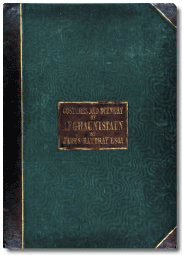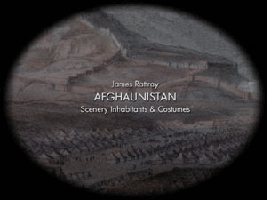 |
|||
| Rendering Afghanistan in Japanese The reason that we called this exhibition gSplendid Afghanistan 1848: James Rattray's Lithographs of the Costumes and the Sceneryh is because we wanted to show that as opposed to somber images that associate Afghanistan with war, terrorism, and bloodshed, it is a country of splendorous and rich culture. One way in which Afghanistan was rendered in Japanese in the Meiji period was by using the Chinese characters g¢x¾g , which is pronounced gAfugan.h Around the Meiji/Taisho period, Afghanistan was referred to as gAfuganisutan,h using characters such as h¢x¾zS.h The Collected Works of Rattray  Rattrayfs works, as presented in this exhibition were published in London as a collection with the title The Costumes of the Various Tribes, Portraits of Ladies of Rank, Cerebrated Princes and Chiefs, Views of the Principal Fortresses and Cities, and Interior of the Cities and Temples, Afghaunistaun. Rattray traveled to Afghanistan in 1841 and participated in the latter half of the First Anglo-Afghan War. Four lithographers including Robert Carrick created lithographs based on his sketches, and they were published along with a commentary by the artist. Rattrayfs works, as presented in this exhibition were published in London as a collection with the title The Costumes of the Various Tribes, Portraits of Ladies of Rank, Cerebrated Princes and Chiefs, Views of the Principal Fortresses and Cities, and Interior of the Cities and Temples, Afghaunistaun. Rattray traveled to Afghanistan in 1841 and participated in the latter half of the First Anglo-Afghan War. Four lithographers including Robert Carrick created lithographs based on his sketches, and they were published along with a commentary by the artist.
The artist dedicated this collection to the Candahar Force that he belonged to and the British and Indian officers who participated in this war. In many cases, the artistfs commentary, rather than being an explanation of the pictures themselves, is an explanation about the harrowing experiences of British troops in Afghanistan, which the artist faced by himself or heard from others. However, one does not gain this impression simply by looking at the lithographs themselves. While scenes of battlefields and garrisons were no doubt important to the British at the time, for us, today, at first glance, they appear to be nothing more than scenes of Afghanistan. Moreover, they possess an extremely rare value in that they show us the ways of life and customs of Afghanistan. As Ethnography An example of ethnography in Afghanistan by Europeans is Mountstuart Elphinstone’s Account of the Kingdom of Cabul and its Dependencies in Persia and India (1815). His descriptions are systematic and to this day, have not lost their academic value, but the illustrations included in this work are poor. Examples of similar works include James Atkinson’s two collections of works:Sketches in Afghaunistan (1842) and Costumes and Scenery of Aghaunistan (1843).The works of Atkinson, who participated in the first half of the war as a military doctor, in one part overlap with and in another part supplement the subject matter of Rattrayfs works. However, regarding the degree of completion and impact as masterpieces, Rattrayfs works are by far superior. Characteristic features of Rattrayfs works are his detailed and vivid depictions of the people living in Afghanistan. In both his works and commentary, he takes great care in depicting clothing. For example, depicted inNo. 24is the burqa, an item of clothing for women in which the face is veiled behind a mesh, and the wearer is completely covered from head to toe; this was made famous in a series of reports on Afghanistan, which is also reprinted in books on the history of clothing. However, in No. 6 and 8, we also see women who wear burqa in which the face can be seen. This is because at that time, the burqa was worn by noblewomen when they went outside and by local peasants and nomads. According to some researchers, it was from the 1960s that the use of the burqa began to spread among rural areas, as it was seen as an urban and fashionable form of clothing. At the same time, however, the burqa tended to be seen as outdated in urban areas. Moreover, in his commentary, the artist eulogizes the fact that the upper class Afghan women in Afghanistan had many more freedoms than those in India and that on many occasions, he came across women enjoying picnics with their burqas removed. It seems that there once existed a much more easy-going world than the one reported in the news today. Rattrayfs work also provides us with a wide range of information that is of historical and ethno-historical interest, such as the forms of worship at tombs and mosques, and the kinds of imperial rituals of the Dorranis. A Keen Interest in Orientalism Finally, the lithographs of Rattray were, at the end of the day, produced for the benefit of the British people. Thus, for example, in No. 29, we see the strong influence of British Orientalism. We can also observe the sections of the commentary relating to judgments have extreme prejudices against Islam. Even though Rattray was a soldier, he had a good command of Persian and spoke directly with local people; more than anything, he had a tireless interest in any information related to Afghanistan. This is completely different to the current situation in which only war and the number of casualties make news. At this time when Japanfs role in Afghanistan is being questioned, we hope you take this chance to experience the colorful culture of Afghanistan. Navigation Movie  The exhibition venue features a tragic yet beautiful gnavigation movieh so as to give visitors a sense of what life was like in RattrayRattrayfs sketches of Afghanistan 170 years ago and allow them to get close to the people who lived at this time. The exhibition venue features a tragic yet beautiful gnavigation movieh so as to give visitors a sense of what life was like in RattrayRattrayfs sketches of Afghanistan 170 years ago and allow them to get close to the people who lived at this time.View Navigation Movie>>
|